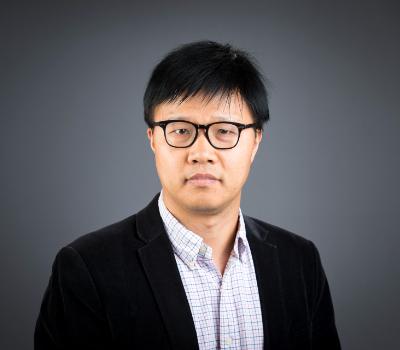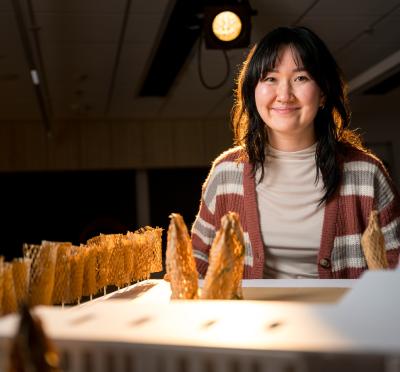Brian Staes, Oregon State University Civil Engineering Student
Brian Staes grew up in hurricane-prone Florida. His father is a roadway design engineer. His mother, who serves as associate director of the Center for Urban Transportation Research at the University of South Florida, was recently appointed to the federal Transit Advisory Committee for Safety by Transportation Secretary Pete Buttigieg.
So, perhaps it’s not too surprising that Staes would pursue a doctorate in civil engineering with a transportation emphasis at Oregon State University, an hour’s drive from the Pacific Ocean, where tsunami warning signs dot the coast highway.
Staes’ research at the College of Engineering focuses on better understanding natural hazard impacts on traffic congestion and evacuation routes, and how best to prioritize and rebuild transportation infrastructure following events such as hurricanes, tsunamis, and wildfires.
“I’m interested in what type of damage will be done to the infrastructure over the course of the evacuation, what is the reduction in operational capacity, and how will the infrastructure rebound toward future natural hazards,” Staes said.
Because hurricanes cover broad swaths of land over several days, relevant transportation data is easier to obtain and analyze from those events than from earthquakes and tsunamis, which impact smaller areas in a matter of minutes. But Staes applies existing transportation research data and analysis to a range of natural hazard scenarios in order to determine the most effective evacuation routes and identify segments that should be prioritized for future natural disasters.
“My dissertation is about resiliency in the face of natural hazards,” said Staes, whose co-advisors are Haizhong Wang, associate professor of transportation engineering and an expert in traffic flow, and Robert Bertini, professor and head of the School of Civil and Construction Engineering. Prior to joining Oregon State, Bertini directed the Center for Urban Transportation Research in Florida, where Staes worked as a graduate research assistant, gathering and analyzing data on highway networks.
“The main goal is to create resiliency metrics of a roadway system so that we can better inform agencies like the Oregon Department of Transportation about where best to invest in infrastructure improvements that will enable safer evacuation routes,” Staes said.
Staes earned his bachelor’s degree in civil engineering from Florida Gulf Coast University and his master’s from the University of South Florida before coming to Oregon State. He won the Pacific Northwest Transportation Consortium Student of the Year Award in 2021 and was recently awarded his fourth Dwight David Eisenhower Transportation Fellowship.
If he had a magic wand, Staes says, he would dramatically increase global research into new, cleaner energy sources, like fusion, as well as innovative transportation infrastructure, including rail transit.
Although far from his childhood home, Staes enjoys living in Western Oregon. “The heat in Florida drains me,” he said. “I like the cold here in Oregon, and I like the rain, too.”
Staes’ postgraduate plans involve more research, then pursuing a career in academia or becoming a consultant.
Having grown up with parents who often discussed how transportation infrastructure was built and how it might be improved, Staes says he often wonders about how the expertise of those who work in the field can be translated into effective policy.
Question
“How can private practitioners, like engineers or consultants — when they observe an issue with the transportation system that might be reducing safety or the capacity of the facility — relay this to local or state agencies in a way that will help them take action?”
Shaun Quayle, Senior Traffic Signal and Safety Engineer
When Shaun Quayle, B.S. civil engineering ’02, was growing up in Tigard, Oregon, he often found himself waiting at traffic lights that didn’t work the way he thought they should.
“I got into traffic engineering out of that frustration,” Quayle said. “I’m an engineer at heart; I want things to work really well. So, it was pretty hard watching those lights not do that. Sometimes I think maybe God had a sense of humor and said, ‘Oh, so you think you’re so smart and good at math, eh? Well, then you get to figure out this traffic signal stuff.’”
That’s what Quayle’s been doing ever since. After graduating from Oregon State, he earned a master’s degree in traffic engineering from the University of Tennessee.
For more than two decades, Quayle has worked in transportation engineering, first as a consultant, then for Washington County in Oregon, and most recently at INRIX, a private software company that collects, analyzes, and distributes traffic data globally to improve safety and mitigate congestion through intelligent mobility.
Quayle joined INRIX about a year ago and works remotely from Orlando, Florida, as a senior traffic signal and safety engineer. The company collects data like travel time, speed, and congestion via trucking agencies, mobile phone providers, and automobile manufacturers around the world. This data is then fused together and analyzed using algorithms to reliably calculate what’s happening on roadways. INRIX stores the data and supplies it to traffic engineers worldwide. The company also issues an annual “Global Traffic Scorecard” of the world’s most congested roadways.
Quayle’s connection to Oregon State helped him supply doctoral student Brian Staes with INRIX data collected on the Florida Turnpike during evacuation from Hurricane Irma in 2017. That data is helping Staes advance his research into developing best practices for evacuation and infrastructure recovery during and after tsunamis and other natural hazard events.
“The beauty of this data is that we are able to look back in time at specific events and see with good clarity what happened on roadways,” Quayle said. “We can see the impacts of the COVID pandemic, for example, or what happened in a certain location at a specific time. We can also turn this data into safety-predictive metrics, like where are people braking hard, etc.”
One new signal technology that sparks Quayle’s passion is smart red-light treatment, which uses highly accurate sensors to track the speed of vehicles approaching an intersection. When the probability of a vehicle running a red light appears high, the green signal can be delayed by a second or two, preventing a potential collision and saving lives.
“In transportation works, seconds matter,” Quayle said. “If we have the technology to provide an extra level of safety when and where it’s needed, let’s provide that.”
Having worked in both the public and private sectors, Quayle suggests the best way for engineers to communicate traffic-system concerns to state and local agencies is to think about the bigger picture and to put themselves in the agency’s shoes.
Answer
“Think through all the different dimensions of the data you’re presenting, including how it might impact the immediate community, the agency’s staff, etc.,” Quayle said. “Consider how they might interpret and process your request, and be sure to take your research a step further by thinking about how it might get put into practice in the real world.”




